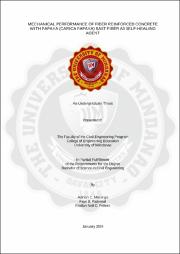Mechanical performance of fiber reinforced concrete with papaya (Carica papaya) bast fiber as self-healing agent

View/
Date
2024-01Author
Maningo, Adrian
Padernal, Faye
Peñero, Froilan Neil
Citation Tool
Metadata
Show full item recordAbstract
This study investigates the potential of Durian Rinds Fiber (DRF) and synthesized Self-Healing Material derived from Durian Rinds (SHM-DRF) as cement replacements to mitigate cracks and enhance the physical and mechanical properties of concrete, particularly in disaster-prone regions like the Philippines. Evaluating the impact of DRF and SHM-DRF at different replacement percentages (1%, 3%, and 5%), the research explores properties such as water absorption, density, and mechanical behavior through destructive and non-destructive tests. Utilizing SEM-EDX, TGA, BET, and visual observation, the study reveals significant improvements in mechanical, microstructural, thermal, and water absorption properties. DRF enhances tensile strength notably, reaching 275.36 MPa ± 52.70, while SHM-DRF contributes to CaCO3 formation crucial for sealing and healing concrete cracks. The findings suggest varying influences of replacement percentages on strength, with DSH1 displaying the highest compressive strength (31.75 MPa ± 2.52) and best self-healing efficiency. At the same time, DSH3 exhibits the highest flexural strength (4.53 MPa ± 0.28).
Collections
- Undergraduate Theses [639]
Publisher
College of Engineering Education
